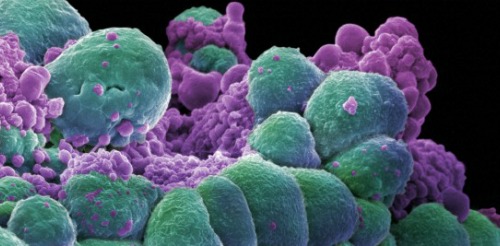
When cancer strikes, it acts like a software program that has gotten out of control — instead of the code for normal cells, a code for making abnormal cells is executed. Now, scientists may have figured out a way to ‘hack’ into this process and change the code so that cancer cells revert back to normal cells.
The findings, published in the journal Nature Cell Biology, reveal “an unexpected new biology that provides the code, the software for turning off cancer,” said senior investigator Dr. Panos Anastasiadis, a professor of cancer biology at the Mayo Clinic in Jacksonville, FL.
The discovery centers around the role of adhesion proteins — the glue that keeps cells together to form tissue — and how they interact with microRNAs (miRNAs), which are the molecules that orchestrate cell programs by regulating gene expression.
The study shows that when normal cells come together, a specific group of miRNAs suppresses genes that encourage cell growth. But, for some reason, this is disrupted in tumor cells, and growth becomes uncontrolled — the hallmark of cancer.
The researchers found when they restored normal miRNA signals in cancer cells, they could reverse the process so growth did not get out of control.
Two-faced molecules
The team became interested in the problem when they tried to reconcile conflicting results that were coming to light about two adhesion proteins: E-cadherin and p120 catenin. These adhesion proteins are important for normal tissue formation, and for a long time were thought to be tumor suppressors.
However, the team began to question the assumptions surrounding E-cadherin and p120 catenin because both molecules are found in tumor cells and appear to be important for tumor growth, too.
It was these seemingly contradictory findings that led Dr. Anastasiadis to speculate that the molecules in question might actually have “two faces” — a “good one” that helps keep normal cells behaving correctly, and a “bad one” that drives tumor growth.
During previous research, the team discovered that this seems to be the case, but were not able to explain how or why this happened. It was not until they studied a new protein — PLEKHA7, which is linked to E-cadherin and p120 — that they found the answer.

Lead authors Panos Anastasiadis, Ph.D., and Antonis Kourtidis, Ph.D. (Photo: Mayo Clinic)
In this latest study, the researchers showed that the new protein is essential for ensuring E-cadherin and p120 maintain their “good face” and stick to their tumor suppression role.
When PLEKHA7 is lost, the adhesion complex that ensures that E-cadherin and p120 keep their “good face” on is disrupted, the miRNAs become misregulated, and E-cadherin and p120 switch to their “bad face” and become tumor-promoting, the researchers explain.
This appears to be an “early and somewhat universal event in cancer,” said Dr. Anastasiadis. In the vast majority of human tumor samples they looked at, they found the adhesion complex was missing, while E-cadherin and p120 were still present.
This is like a speeding car that has a lot of gas (E-cadherin and p120) but no brakes (the PLEKHA7 complex), he explained. With their new discovery, they hope to “put the brakes” on this malignant process.
“By administering the affected miRNAs in cancer cells to restore their normal levels, we should be able to re-establish the brakes and restore normal cell function,” said Dr. Anastasiadis. “Initial experiments in some aggressive types of cancer are indeed very promising.”
The study brings together two fields of biology — cell-to-cell adhesion and miRNA biology — that until now, have not normally worked together.
“Most significantly,” said lead author Dr. Antonis Kourtidis, “it uncovers a new strategy for cancer therapy.”
